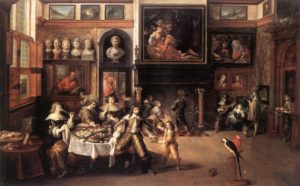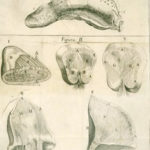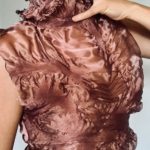Supper at the House of Nicolaas Rockox
Frans Francken II. Supper at the House of Burgomaster Rockox, c. 1630-35 (oil on panel, 62 x 97 cm). Alte Pinakothek, Munich.
In Supper at the House of Burgomaster Rockox, the Flemish painter Frans Francken the Younger described, with a warm palette of earthy, reddish, green and golden tones, what at first sight appears as a Preziosenwand (‘wall of precious things’), that is, a curious variation of still life painting, devoted to the lavish display of a collector’s cabinet. However, if the viewer looks closer, and allows their gaze to be guided by the artist’s brushstroke, and wander through the room, they will discover that the real protagonist of the picture is not the wall crammed with paintings in a sort of horror vacui, nor the books, and the seashells on top of the table under the window. The centre of the image is the banqueting table and the very act of tasting.
First, the eye of the viewer is drawn towards the thin, long, and delicate fingers of a gentleman’s hand, delicately picking an oyster from the central table piece. Traditionally regarded as a moral allegory of virtue, the gestural act of picking an item out from a copious array of objects, may also be read as a representation of taste as judgment. However, the picking hand is not the only bodily gesture that suggests another meaning of taste. The table, fully covered in white cloth, is architecturally arranged and set with symmetry and harmony: round pewter plates mimicking the roundness of their content, that is, fresh oysters, cakes and pies, citrus fruit cut in halves, a loaf of bread, and a knife with its handle discretely placed outside the limits of the table, inviting the viewer for consumption. This constitutes a compositional device conventionally employed in still life painting, where every trace of human presence are erased, positioning the viewer outside the frame. Seduced by the illusionistic trick in hands of the painter, the viewer mimics the diners’ gesture, extending their arm to reach and take the breadknife, accepting the burgomaster’s invitation for dinner. Oil painting does not only quench the thirst of the wood (the artist’s choice of support medium), and it does not only lubricate the eye of the viewer, but also their mouths, making them salivate in presence of the painted fruit of the earth and delicacies from the sea. However, in this painting, conventional rules are being broken. Not only does human presence disrupt the otherwise harmonious order of a still life painting or a gallery picture. Furthermore, rather than distantly engaging with the objects in the collection via an aseptic gaze, diners are shown at the very moment they grab their metal forks and transparent tall wine glasses, and pull them closer to their open mouths, not in wonder, but in anticipation to consumption, turning the painting into a banquet scene. Thus, in this hybrid interior space, the painter chose to present in an unconventional setting, that is, the cabinet, what is traditionally erased from the history of art, or otherwise marginalized by the official aesthetic and disciplinary canon as lower genres: the open mouth.
On the opposite side of the room, appears another set of figures, including a lute player, and a woman comfortably sitting in a chair, gently grabbing a flower by the stem with the thumb and middle fingers of her left hand, and a white cloth handkerchief with her right hand, in the same gestural fashion as the oyster picker. An aesthetically arranged flower vase stands in front of her on the wooden floor, once more, in a sort of independent still life painting, once more transgressed by human presence.
This painting presents a visual repository of the different items in the collection of Nicolaas Rockox, Mayor of Antwerp, patron and close friend of the celebrated Flemish artist Peter Paul Rubens. An inventory of his collection offers a detailed description of his possessions, while modern readings tend to focus on his vast and valuable collection of paintings—some of which are rendered visible in Francken’s painting. At the top middle space of the wall, hangs Rubens’ Samson and Delilah. Right below it lies the fireplace. A further reading of Rockox’ House inventory conveys relevant information about the burgomaster’s kitchen collection: cooking utensils, including spits, grills, frying pans, and waffle makers, as well as pewter plates, bowls, pots, tins, salt cellars, cutlery and cups. Frans Francken II thus makes these objects of taste visible, placing them in the room altogether with other objects of sight, touch, earth, sea, fire, and wonder, itemising them in an unorthodox system that resists modern classification. This picture itself goes beyond the limits of pictorial convention.
Moreover, Francken’s painting may not only be read as a pictorial translation of Rockox’ material repository, that is, as visual description of objects, but also of spaces and performances. While the early modern banquet is now recognized as a multi-sensory experience, featuring a number of musical performances and visually and architecturally spectacular entremets (Kirshenblatt-Gimblett 2006), the cabinet of curiosities is still largely regarded as the palace of the eye. However, the early modern collection was meant to be experienced with all of the senses, and taste is no exception (Classen 2007). The “pranketing” room constituted a hybrid space built to fulfill the double function of cabinet and banqueting house (Claxton 2010). In that sense, Francken’s hybrid scene could be regarded as one of the few surviving depictions of the early modern pranketing room, that is, the house of the double meaning of taste.
Later on, in his Essay Concerning Human Understanding, the English philosopher John Locke stated that the mind is like a cabinet. If the mind dwells within the walls of the banquet room, a space where the table, the open mouth, and the very act of tasting become the house of thinking, could this painting offer a glimpse into the owner’s private experience of taste? Could it maybe open the door towards the mystery of taste as a metaphor?
Laura Eliza Enríquez
Concordia University, Montreal, Canada
Bibliography
Classen, Constance. 2007. “Museum Manners: The Sensory Life of the Early Museum.” Journal of Social History 40(4): 895-914.
Claxton, Juliet. 2010. “The Countess of Arundel’s Dutch Pranketing Room.” Journal of the History of Collections 22(2): 187-196.
Kirshenblatt-Gimblett. 2006. “Making Sense of Food in Performance: The Table and the Stage.” The Senses in Performance. New York: Routledge.
Locke, John. 1975. An Essay Concerning Human Understanding. Oxford: Clarendon Press.
Rockoxhuis. Inventory 77.88.


